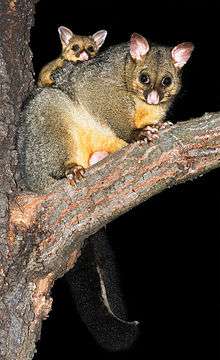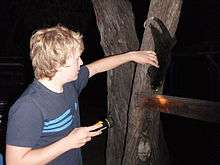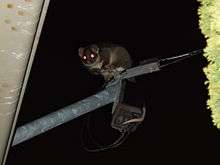Phalangeriformes
| Phalangeriformes | |
|---|---|
 | |
| Common brushtail possum (Trichosurus vulpecula) | |
| Scientific classification | |
| Kingdom: | Animalia |
| Phylum: | Chordata |
| Class: | Mammalia |
| Infraclass: | Marsupialia |
| Order: | Diprotodontia |
| Suborder: | Phalangeriformes Szalay in Archer, 1982 |
| Superfamilies and Families | |
Phalangeriformes is a suborder of any of about 70 small- to medium-sized arboreal marsupial species native to Australia, New Guinea, and Sulawesi (and introduced to New Zealand and China). The suborder includes animals commonly known as possums, gliders, and cuscus. The common name "possum" for various Phalangeriformes species derives from the creatures' resemblance to the opossums of the Americas (the term comes from Powhatan language aposoum "white animal", from Proto-Algonquian *wa·p-aʔɬemwa "white dog"). However, although opossums are also marsupials, Australasian possums are more closely related to other Australasian marsupials such as kangaroos.
Phalangeriformes are quadrupedal diprotodont marsupials with long tails. The smallest species, indeed the smallest diprotodont marsupial, is the Tasmanian pygmy possum, with an adult head-body length of 70 mm (2 3⁄4 in) and a weight of 10 g (3⁄8 oz). The largest are the two species of bear cuscus which may exceed 7 kg (15 lb 7 oz). Phalangeriformes species are typically nocturnal and at least partially arboreal. They inhabit most vegetated habitats, and several species have adjusted well to urban settings. Diets range from generalist herbivores or omnivores (the common brushtail possum) to specialist browsers of eucalyptus (greater glider), insectivores (mountain pygmy possum) and nectar-feeders (honey possum).
Classification



About two-thirds of Australian marsupials belong to the order Diprotodontia, which is split into three suborders: the Vombatiformes (wombats and the koala, four species in total); the large and diverse Phalangeriformes (the possums and gliders) and Macropodiformes (kangaroos, potoroos, wallabies and the musky rat-kangaroo). Note: this classification is based on Ruedas & Morales 2005.
- Suborder Phalangeriformes: possums, gliders and allies
- superfamily †Ektopodontoidea
- family †Ektopodontidae
- Genus †Ektopodon
- †Ektopodon serratus
- †Ektopodon stirtoni
- †Ektopodon ulta
- Genus †Ektopodon
- family †Ektopodontidae
- Superfamily Phalangeroidea
- Family Burramyidae: pygmy possums
- Genus Burramys
- Mountain pygmy possum, B. parvus
- Genus Cercartetus
- Long-tailed pygmy possum, C. caudatus
- Southwestern pygmy possum, C. concinnus
- Tasmanian pygmy possum, C. lepidus
- Eastern pygmy possum, C. nanus
- Genus Burramys
- Family Phalangeridae: brushtail possums and cuscuses
- Subfamily Ailuropinae
- Genus Ailurops
- Talaud bear cuscus, A. melanotis
- Sulawesi bear cuscus, A. ursinus
- Genus Strigocuscus
- Sulawesi dwarf cuscus, S. celebensis
- Banggai cuscus, S. pelegensis
- Genus Ailurops
- Subfamily Phalangerinae
- Tribe Phalangerini
- Genus Phalanger
- Gebe cuscus, P. alexandrae
- Mountain cuscus, P. carmelitae
- Ground cuscus, P. gymnotis
- Eastern common cuscus, P. intercastellanus
- Woodlark cuscus, P. lullulae
- Blue-eyed cuscus, P. matabiru
- Telefomin cuscus, P. matanim
- Southern common cuscus, P. mimicus
- Northern common cuscus, P. orientalis
- Ornate cuscus, P. ornatus
- Rothschild's cuscus, P. rothschildi
- Silky cuscus, P. sericeus
- Stein's cuscus, P. vestitus
- Genus Spilocuscus
- Admiralty Island cuscus, S. kraemeri
- Common spotted cuscus, S. maculatus
- Waigeou cuscus, S. papuensis
- Black-spotted cuscus, S. rufoniger
- Blue-eyed spotted cuscus, S. wilsoni
- Genus Phalanger
- Tribe Trichosurini
- Genus Trichosurus
- Northern brushtail possum, T. arnhemensis
- Short-eared possum, T. caninus
- Mountain brushtail possum, T. cunninghami
- Coppery brushtail possum, T. johnstonii
- Common brushtail possum, T. vulpecula
- Genus Wyulda
- Scaly-tailed possum, W. squamicaudata
- Genus Trichosurus
- Tribe Phalangerini
- Subfamily Ailuropinae
- Family Burramyidae: pygmy possums
- Superfamily Petauroidea
- Family Pseudocheiridae
- Subfamily Hemibelideinae
- Genus Hemibelideus
- Lemur-like ringtail possum, H. lemuroides
- Genus Petauroides
- Greater glider, P. volans
- Genus Hemibelideus
- Subfamily Pseudocheirinae
- Genus Petropseudes
- Rock-haunting ringtail possum, P. dahli
- Genus Pseudocheirus
- Common ringtail possum, P. peregrinus
- Genus Pseudochirulus
- Lowland ringtail possum, P. canescens
- Weyland ringtail possum, P. caroli
- Cinereus ringtail possum, P. cinereus
- Painted ringtail possum, P. forbesi
- Herbert River ringtail possum, P. herbertensis
- Masked ringtail possum, P. larvatus
- Pygmy ringtail possum, P. mayeri
- Vogelkop ringtail possum, P. schlegeli
- Genus Petropseudes
- Subfamily Pseudochiropinae
- Genus Pseudochirops
- D'Albertis' ringtail possum, Pseudochirops albertisii
- Green ringtail possum, Pseudochirops archeri
- Plush-coated ringtail possum, Pseudochirops corinnae
- Reclusive ringtail possum, Pseudochirops coronatus
- Coppery ringtail possum, Pseudochirops cupreus
- Genus Pseudochirops
- Subfamily Hemibelideinae
- Family Petauridae
- Genus Dactylopsila
- Great-tailed triok, D. megalura
- Long-fingered triok, D. palpator
- Tate's triok, D. tatei
- Striped possum, D. trivirgata
- Genus Gymnobelideus
- Leadbeater's possum, G. leadbeateri
- Genus Petaurus
- Northern glider, P. abidi
- Yellow-bellied glider, P. australis
- Biak glider, P. biacensis
- Sugar glider, P. breviceps
- Mahogany glider, P. gracilis
- Squirrel glider, P. norfolcensis
- Genus Dactylopsila
- Family Tarsipedidae
- Genus Tarsipes
- Honey possum or noolbenger, T. rostratus
- Genus Tarsipes
- Family Acrobatidae
- Genus Acrobates
- Feathertail glider, A. pygmaeus
- Genus Distoechurus
- Feather-tailed possum, D. pennatus
- Genus Acrobates
- Family Pseudocheiridae
- superfamily †Ektopodontoidea
In New Zealand
The common brushtail possum was introduced to New Zealand by European settlers in an attempt to establish a fur industry. There are no native predators of the possum in New Zealand, so its numbers in New Zealand have risen to the point where it is considered a serious pest. Numerous attempts to eradicate them have been made because of the damage they do to native trees and wildlife, as well as acting as a carrier of bovine tuberculosis. By 2009, these measures had reduced the possum numbers to less than half of the 1980s levels – from around 70 million to around 30 million animals.[1]
See also
- Fauna of Australia
- Opossum - distantly related marsupial of the Americas
References
- ↑ "New research estimates there are about 30 million possums in New Zealand". Landcare Research. 9 December 2009. Retrieved 6 April 2011.
Further reading
- Possums and Gliders — Australia Zoo
- Urban Possums — ABC (Science), Australian Broadcasting Corporation
- Ruedas, L.A.; Morales, J.C. (2005). "Evolutionary relationships among genera of Phalangeridae (Metatheria: Diprotodontia) inferred from mitochondrial data". Journal of Mammalogy. 86 (2): 353–365. doi:10.1644/BER-117.1. JSTOR 4094355. Archived from the original on 11 August 2013.
- Possums or Opossums? on Museum of New Zealand Te Papa Tongarewa